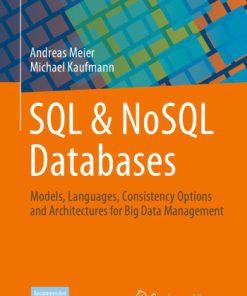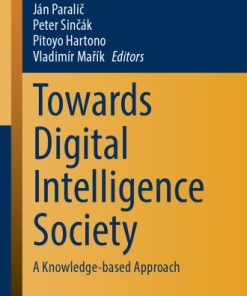eDemocracy eGovernment Stages of a Democratic Knowledge Society Andreas Meier 3030175855 9783030175856
$50.00 Original price was: $50.00.$25.00Current price is: $25.00.
This completed downloadable of eDemocracy eGovernment Stages of a Democratic Knowledge Society Andreas Meier

Instant downloaded eDemocracy eGovernment Stages of a Democratic Knowledge Society Andreas Meier pdf docx epub after payment.
Product details:
- ISBN 10: 3030175855
- ISBN 13: 9783030175856
- Author: Andreas Meier
This textbook reviews and systematically presents the use of the Internet in public administration and politics. Further, it employs a process-oriented layer model to define the opportunities for exchange and participation for all stakeholder groups, covering the following topics: eAssistance, eProcurement, eService, eContracting, eSettlement, eCollaboration, eDemocracy, and eCommunity. In turn, real-world case studies demonstrate the practical applications in industry, administration and research. The second edition of this book has been completely revised and extended, and includes several new case studies. It offers a valuable asset for students in Business, Economics and Political Sciences courses, as well as practitioners interested in emerging opportunities for digital exchange and participation in the knowledge society.
Table of contents:
Chapter 1: eGovernment Framework
1.1 The Lisbon Declaration
1.2 Definition of eDemocracy and eGovernment
1.3 Components of the eGovernment Framework
1.4 Differentiation from eBusiness and eCommerce
1.5 Chapter Overview
1.6 Bibliographical Notes
Chapter 2: eAssistance
2.1 Search andWeb Services in the Internet
2.2 Web Development
2.2.1 Web 1.0 – StaticWeb
2.2.2 Web 2.0 – The Writing and Participating Web
2.2.3 Web 3.0 – The Semantic Web
2.2.4 Web 4.0 – Open, Linked, and Intelligent Web
2.3 Catalog for MunicipalityWeb Sites
2.4 Design of eGovernment Portals
2.5 Barrier-Free Web Access
2.6 Quality Assurance in the Internet
2.7 Bibliographical Notes
2.8 Case Study—Web Accessibility From a Systems Approach
2.8.1 Background
2.8.2 About Social Dimensions and Ongoing Programs for Inclusion
2.8.3 Case Study:Website of the Technical Secretariat for the Inclusive Management on Disabilities
2.8.4 Future Work and Conclusions
2.8.5 References
Acknowledgment
Contact Address
Profile of Authors
Chapter 3: eProcurement
3.1 Internet-Based Procurement Process
3.2 Procurement Model Seller-Side
3.3 Procurement Model Buyer-Side
3.4 Marketplace Procurement
3.5 Public Offering via Internet
3.6 Conducting Auctions
3.7 Desktop Purchasing
3.8 Bibliographical Notes
3.9 Case Study—Inverse Auctions at the Procurement Agency of Swiss Federal Railways
3.9.1 Background
3.9.2 Case Studies of Inverse Auctions in the SBB
3.9.3 Case Example A—Procurement of a Service
3.9.4 Case Example B—Procurement of Clothing
3.9.5 Case Example C—Procurement ofWorking Clothes
3.9.6 Case Example D—Procurement of a Service
3.9.7 Opportunities and Risks
Contact Details
Profile of Authors
Chapter 4: eService
4.1 Technical, Organizational, and Semantic Interoperability
4.2 Electronic Governmental Services for Citizens
4.3 eGovernment Services for Businesses
4.4 Municipality Product Plan
4.5 eHealth Architecture for Mobile Services
4.6 Capability Maturity Model for the eGovernment Benchmarking
4.7 Bibliographical Notes
4.8 Case Study—The Austrian Electronic Health Record System ELGA
4.8.1 Background
4.8.2 Case Study
4.8.3 Opportunities and Risks
Further Reading
Contact Details
Profile of Authors
Chapter 5: eContracting
5.1 Electronic Contracts
5.2 Generic Services for the Negotiation Process
5.3 Identity Management
5.4 Asymmetric Encryption
5.5 Sealing Electronic Documents with Digital Signatures
5.6 Public Key Infrastructure
5.7 Blockchain as a Distributed Ledger with Consensus
5.7.1 The Blockchain Data Structure
5.7.2 Solving a Cryptographic Task
5.7.3 The Criterion of the Longest Block Chain
5.7.4 Blockchain Options for eGovernment
5.8 Legal Aspects
5.9 Bibliographical Notes
5.10 Case Study—Face Recognition in the Biometric Passport
5.10.1 Background
5.10.2 Case Study on Biometric Data in Passports
5.10.3 Opportunities
5.10.4 Risks
5.10.5 Conclusion
Further Reading
Contact Details
Profile of author
Chapter 6: eSettlement
6.1 Sub-Steps of a Supply Chain
6.2 Classification ofWeb-Based Payment Systems
6.3 Online Versus Offline Distribution
6.4 Protection of Personal Data
6.5 Protection of Copyright
6.6 Security Management
6.7 General Data Protection Regulation
6.8 Bibliographical Notes
6.9 Case Study—Safeguards on Data Exchange of Salzburg Research
6.9.1 Background
6.9.2 Case Study—Disregarding of Data Protection and Defense Measures
6.9.3 Opportunities and Risks
Further Reading
Contact Details
Profile of Authors
6.10 Case Study—Consent Management System: A Case Study of BitsaboutMe Platform
6.10.1 Background
6.10.2 EU Data Protection Regulation
6.10.3 Case Study – BitsaboutMe Platform
6.10.4 Consent Management System
6.10.5 Lessons Learned
Further Readings
Contact Details
Profile of Authors
Chapter 7: eCollaboration
7.1 Document Management
7.2 Content Management
7.3 Wiki Tools
7.4 Use ofWeblogs
7.5 Collaborative Working Environment
7.6 Virtual Organization and Forms of Cooperation
7.7 Bibliographical Notes
7.8 Case Study—Learning Environment Virtual Campus at the University of Hagen
7.8.1 Background
7.8.2 Case Study—Characteristics of a Virtual Campus
7.8.3 Changes in Learning and Teaching
7.8.4 Communication and Interaction
7.8.5 Cooperation
7.8.6 Exams and Examination Regulations
7.8.7 Supervision Relationship
7.8.8 Changes in the Organization
7.8.9 Opportunities and Risks
Further Reading
Contact Details
Profile of Author
7.9 Case Study—Implementing Accessibility in Massive Open Online Courses’ Platforms for Teaching
7.9.1 Background
7.9.2 Case Description
7.9.3 Barriers
7.9.4 Discussion and Evaluation
7.9.5 Conclusions
Further Reading
Contact Details
Profile of Authors
Chapter 8: eDemocracy
8.1 Pyramid of Types of Participation
8.2 Variety of Electronic Voting and Elections
8.3 Process Steps for eVoting and eElection
8.4 Operation of Electronic Voting and Elections
8.5 Blockchain-based eVoting Systems
8.6 Analysis and Visualization of Multidimensional Data
8.7 Steps to Public Memory
8.8 Bibliographical Notes
8.9 Case Study—What Voting Advice Applications can Tell us About Voters
8.9.1 Background
8.9.2 State of the Art
8.9.3 A Brief Look at Data from Ecuador
8.9.4 Summary
Further Readings
Contact Details
Profile of Authors
8.10 Case Study—Technical and Procedural Mechanisms to Enhance Transparency and Trust in Internet
8.10.1 Background – Internet Voting in Switzerland
8.10.2 Scytl and Swiss Post’s Online Voting Solution for Swiss Elections
8.10.3 Discussion and Evaluation
Further Readings
Contact Details
Profile of Authors
Chapter 9: eCommunity
9.1 Push vs. Pull Communication Strategies
9.2 Multi-Channel Management
9.3 Establishment of a Citizen Communication Center
9.4 Development Model for Online Citizen
9.5 Performance Review for PublicWeb Platforms and Portals
9.6 Tools for Community Building
9.7 Impact of Social Networks in Public Administration
9.8 Bibliographical Notes
9.9 Case Study—Medical Communication Center supported by the Swiss Center for Telemedicine
9.9.1 Background
9.9.2 Case Medgate
9.9.3 Chances and Risks
Further Reading
Contact Details
Profile of Author
9.10 Case Study—Participa Inteligente: A Social Network Platform for Citizens’ Discussion and Pa
9.10.1 Background
9.10.2 Current State of Research in the Field
9.10.3 Impact Evaluation
9.10.4 Outlook
Further Reading
Contact Details
Profile of Author
Chapter 10: Knowledge Society
10.1 Decentralization in the New Public Management
10.2 Toward the Information and Knowledge Society
10.3 Use of Knowledge-Based Databases
10.4 Development of a Knowledge Society
10.5 Dangers and Risks of a Knowledge Society
10.6 Ethic Rules in the Knowledge Society
10.7 Bibliographical Notes
10.8 Case Study—Cognitive Cities*
10.8.1 Today’s City: Between “Smart” and “Cognitive”
10.8.2 Cognitive Systems and Cognitive Computing
10.8.3 From Cognitive Computing to Cognitive Cities
People also search:
democracy government system
stages of government
a democracy government
a democratic government
stages of a democracy
You may also like…
Politics & Philosophy - Social Sciences
Politics & Philosophy - Social Sciences
Politics & Philosophy
Democratic Decision Making Consensus Voting For Civic Society And Parliaments Peter Emerson
Computers - Networking
Computers - Programming
Politics & Philosophy
Engineering
Computers - Programming
Python GUI Programming Cookbook 2nd Edition by Burkhard A Meier ISBN 9781787129023 1787129020
Business & Economics - Management & Leadership












